|
|
|
Sort Order |
|
|
|
Items / Page
|
|
|
|
|
|
|
| Srl | Item |
| 1 |
ID:
110279


|
|
|
|
|
| Publication |
2012.
|
| Summary/Abstract |
This article tries to examine the role played by the Army during a natural disaster. India's federal set-up tends to complicates issues and, quite often, politics dominates the humanitarian aspect, which leads to delays in the development of the army. This article is a case study of the Kosi flood of 2008 in Bihar, which was an outstanding example of civil-military cooperation. The article also analyses the successful efforts made by retired Army personnel for curbing the Naxal problems in the state. But the article also poses certain questions: Is the deployment of the army in humanitarian crises good for it? Will political controversies damage the credibility and effectiveness of the Army?
|
|
|
|
|
|
|
|
|
|
|
|
|
|
|
|
| 2 |
ID:
089768
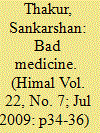

|
|
|
|
|
| Publication |
2009.
|
| Summary/Abstract |
Naxalism is, undeniably, a law-and -order problem, but it is not that alone; the violence Naxalites often wreak is a virulent symptom, not the disease itself. And untill the government realises that, its remedies are doomed to failure. The state government's 22 June ban on the Naxalites following the outbreak in Bengal is a mere updating-the-books exercise, nothing more. Maoist groups had long been banned; it is only that the government had not taken cognisance of their merger into one group.
|
|
|
|
|
|
|
|
|
|
|
|
|
|
|
|
| 3 |
ID:
172226
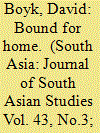

|
|
|
|
|
| Summary/Abstract |
At the turn of the twentieth century, a group of young men in Desna, a qasba (small town) in Bihar, founded an organisation called the Anjuman Al-Islah. There they shared their books in the name of promoting education and cultivation, which they saw as ‘paramount in life’s every undertaking’ and essential to the defence of qasbati culture. Through sustained collaborative efforts, the Anjuman soon built up an impressive library of Urdu books and periodicals. Where other libraries were assembled at the initiative of aristocratic patrons or government officials, the Al-Islah library relied on the contributions of numerous Desnavis, both those who still lived in the qasba and those whose careers had taken them far away. In turn, the Anjuman and its library nurtured Desnavis’ ties to each other and to their watan, or homeland.
|
|
|
|
|
|
|
|
|
|
|
|
|
|
|
|
| 4 |
ID:
126026
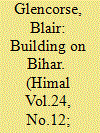

|
|
|
|
|
| Publication |
2011.
|
| Summary/Abstract |
Poor infrastructure, weak human capacity, politicised local bureaucracies, difficult caste relations, debilitating power shortages and deeply entrenched poverty - driving around Bihar recently, it was clear that the state has yet to transform into the orderly, prosperous society that recent press coverage has suggested. That said, there is no doubt that a nascent but carefully structured institutional reform process is allowing for the slow emergence of a 'naya' Bihar. Since 2005, the government of Nitish Kumar has consolidated rule of law, built critical infrastructure, begun to deliver services, increased revenues and expenditures, improved bureaucratic functionality, and generated an important sense of citizenship among many of the state's communities. The economy has grown at over 10 percent per year for the past six years, despite the separation of resource-rich Jharkhand in 2000, periodic floods and droughts, and the recent global financial crisis.
|
|
|
|
|
|
|
|
|
|
|
|
|
|
|
|
| 5 |
ID:
073061
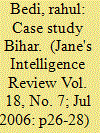

|
|
|
| 6 |
ID:
106263
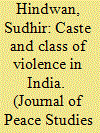

|
|
|
| 7 |
ID:
122562


|
|
|
| 8 |
ID:
100966
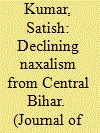

|
|
|
|
|
| Publication |
2010.
|
| Summary/Abstract |
The Naxal problem has become the biggest internal threat to the country. Especially after the comments of the Prime Minister Manmohan Singh in 2007, it has become a matter of concern as well as a subject of academic debate. The new thought, innovative ideas and fresh planning have been developed to address this issue extensively and intensively. In this backdrop, a case study of Central Bihar becomes relevant to focus the light on this issue. It is an established fact that Naxalism in Bihar had made its route through Central Bihar. When the Counterinsurgency mechanism crushed the first bubbles of Naxalism in West Bengal and Andhra Pradesh, it found its breeding ground in Central Bihar. Repeated massacres and Naxal terror in Central Bihar became the concern for the country in 1980s and 1990s. It argues that the changing socio-economic conditions along with other factors massively restricted the Maoist popularity and strength in the Central Bihar.
|
|
|
|
|
|
|
|
|
|
|
|
|
|
|
|
| 9 |
ID:
158943
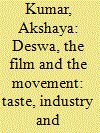

|
|
|
|
|
| Summary/Abstract |
In the last decade, the Bhojpuri film industry has made its presence felt across most of north India, but also in many large cities of peninsular India. However, this emergence has also brought to the fore various questions around taste, class, region and representation. Nitin Chandra’s ‘unreleased’ Bhojpuri film Deswa sought to alter the ‘vulgar’ orientation of this industry, but had to wait for nearly four years to finally release as a Hindi film. Arguing that the vibrant debate that took place on the fundamental distinctions of Deswa is animated by Chandra’s persistent desire to narrate Bihar’s lost glory and utmost disrepair, I assess in this paper the industrial constraints that shaped the journey of Deswa. Drawing contrasts and parallels with the Hindi film industry, and drawing upon Pierre Bourdieu’s theoretical modeling of the field of cultural production, I locate the Deswa debate as a key moment in the contestations over subject positions, industry infrastructure, and linguistic affinities.
|
|
|
|
|
|
|
|
|
|
|
|
|
|
|
|
| 10 |
ID:
105731
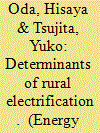

|
|
|
|
|
| Publication |
2011.
|
| Summary/Abstract |
This paper explores intra-state disparity in access to electricity and examines the determinants of electrification at the village level in Bihar, one of the underdeveloped states in India. Our field survey of 80 villages in 5 districts conducted in 2008-09 found that 48 villages (60%) are electrified when using the definition of electrification that a village is electrified if any one household in the village is connected to electricity. In the processes of electrification, approximately 40% of villages have been electrified in recent years. The econometric analyses demonstrate that location is the most important determinant of a village's electricity connection. Another important finding is that with the rapid progress of rural electrification under the recent government program and the tendency to connect the villages that are easily accessible, the collective bargaining power of the village, which used to significantly affect the process of electrification, has lost influence. This adversely affects remote villages. In order to extend electricity supplies to remote and geographically disadvantaged villages, the government needs to consider other options for sustainable electricity supply, such as decentralized distribution of electricity rather than the conventional connection through the national/local grids.
|
|
|
|
|
|
|
|
|
|
|
|
|
|
|
|
| 11 |
ID:
120213
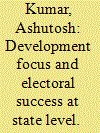

|
|
|
|
|
| Publication |
2013.
|
| Summary/Abstract |
Emergence of regional states in contemporary India as an effective arena for political and economic development has given state-level leaders a growing power. In the present coalition era, which reflects such regionalisation, this brings increasing prominence to effective state-based parties and their leaders. Focusing on recent politics of Bihar, this article shows in what ways Nitish Kumar, Chief Minister of Bihar, since 2005, unlike his predecessor Lalu Yadav, comes across as 'unusual'. Setting aside neo-patrimonial political tendencies, much in vogue among the new crop of state leaders, Nitish Kumar has instead focused on channelling both private and public resources to provide quality governance in an erstwhile 'failed state'. This, more than rootedness in a traditional community or vote bank, may largely explain continued electoral success, though a leader also depends on those around him, with all the risks for effective implementation that this entails.
|
|
|
|
|
|
|
|
|
|
|
|
|
|
|
|
| 12 |
ID:
091727
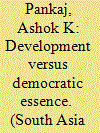

|
|
|
|
|
| Publication |
2009.
|
| Summary/Abstract |
This article reflects on the role of voters' preference for democratic essence over development-related issues in the 2005 Haryana and Bihar Assembly elections. Based on analysis of these elections, it is argued that in a society where the distributive effects of development are less than egalitarian, economic deprivations are reinforced by socio-political inequality, but democracy still promises to be a great equaliser and source of empowerment for the masses. Democratic issues therefore appear to have greater electoral and political appeal than promises of 'development' or small morsels of favour to entice an electorate. This finding indicates an increasingly sophisticated understanding of the Indian electorate about the critical relevance of democracy.
|
|
|
|
|
|
|
|
|
|
|
|
|
|
|
|
| 13 |
ID:
179409
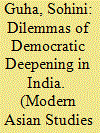

|
|
|
|
|
| Summary/Abstract |
The political assertion by subalterns (specifically lower and backward castes) that India witnessed from the 1990s onwards, and the formation of governments by parties representing these groups in Uttar Pradesh and Bihar, two electorally critical North Indian states, contributed significantly to the deepening of India's democracy. But these lower caste governments met with vehement resistance from privileged strata, and from a section of state actors themselves, in particular, the bureaucracy. These governments adopted a range of strategies to counter this resistance in turn, which had the effect of bringing the procedural and substantive elements of democracy into sharp conflict. The project of lower and backward caste empowerment was defined by a politics of levelling, which placed great value on instantly visible egalitarian outcomes, even when these could only be achieved by denting the rule of law and weakening public institutions. But it was precisely on account of its ability to deliver instant egalitarian fixes (albeit on an ad-hoc and sporadic basis) that this politics commanded so much legitimacy among subordinate groups. Drawing on ethnographic research conducted in Uttar Pradesh, and secondary literature on backward caste politics in Bihar, this article explores the consequences that this prioritizing of right outcomes over proper procedures had on public culture in North India. It argues that this prioritizing of consequences over means bred a widespread impatience with a procedural conception of democracy, which was seen as obstructing the modalities that went to secure justice in real life.
|
|
|
|
|
|
|
|
|
|
|
|
|
|
|
|
| 14 |
ID:
165937
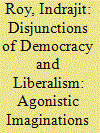

|
|
|
|
|
| Summary/Abstract |
In this paper, I make a case for appreciating the ‘agonistics of democracy’ by reflecting on political changes in the state of Bihar in eastern India since 1990. These changes compel us to appreciate the substantive deepening of democracy in Bihar despite the absence of values commonly associated with liberalism. I first highlight the emergence of ‘Backward Caste’ assertion in the state, which sought to construct the broadest possible alliance against the so-called ‘Forward Castes’ and culminated in the ascendancy of the Janata Dal government of Lalu Prasad Yadav in 1990. I next point to the inchoate antagonism harboured by poor people against the privileged who seek to assert their caste supremacy. Describing the vocabularies of dignity in which such supremacy is contested, I demonstrate that conflict is entwined with co-operation in poor people’s quotidian engagements with the privileged classes. In conclusion, I argue that an ‘agonistics of democracy’ allows us to step beyond the limitations of existing approaches to theorising democracy. I focus in particular on two such approaches: the liberalism-inspired approach dominant in many contemporary readings of democracy in India, and the critical alternatives offered by the political society-centred approach. The agonistic approach to democracy proposed in this paper enables scholars to leverage the strengths of both these approaches while avoiding their pitfalls.
|
|
|
|
|
|
|
|
|
|
|
|
|
|
|
|
| 15 |
ID:
089677
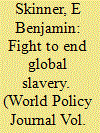

|
|
|
|
|
| Publication |
2009.
|
| Summary/Abstract |
Human trafficking may be just the latest topic du jour among U. S. humanitarian types, but mention the underlying crime- slavery to foreign officials and the rection is often confused and explosive. For God's sake, don't go talking about brutal slavery here, says Jay Kumar, the social secretary of Araria, one of the poorest districts in Bihar, the poorest state in India.
|
|
|
|
|
|
|
|
|
|
|
|
|
|
|
|
| 16 |
ID:
032196
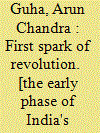

|
|
|
|
|
| Edition |
1st ed.
|
| Publication |
Bombay, Orient Longman, 1971.
|
| Description |
528p.hbk
|
|
|
|
|
|
|
|
|
|
|
|
Copies: C:1/I:0,R:0,Q:0
Circulation
| Accession# | Call# | Current Location | Status | Policy | Location |
| 008281 | 954.0356/GUH 008281 | Main | On Shelf | General | |
|
|
|
|
| 17 |
ID:
118926


|
|
|
|
|
| Publication |
2013.
|
| Summary/Abstract |
This paper attempts to see how a particular labour market (domestic service), a traditionally male domain, became segregated both by gender and age in the post-partition Indian state of West Bengal, and mainly in its capital city Calcutta. It argues that the downward trend in industrial job opportunities in post independent West Bengal, accompanied by the large scale immigration of men, women and children from bordering East Pakistan (now Bangladesh), led to a general decline in wage rate for those in domestic service. Poor refugee women, in their frantic search for a means of survival, gradually drove out the males of the host population who were engaged in domestic service in urban West Bengal by offering to work for a very low wage and often for no wage at all. As poor males from the neighbouring states of Bihar, Orissa and the United Provinces constituted historically a substantial section of Calcutta domestic workers, it was mainly this group who were replaced by refugee women. The second stage in the changing profile of domestic service since the 1970s in urban West Bengal was arguably set by migrating girl children from different parts of the state to Calcutta city in search of employment. This is probably why West Bengal had the highest girl children's work-participation rate in urban India in 2001.
|
|
|
|
|
|
|
|
|
|
|
|
|
|
|
|
| 18 |
ID:
100814
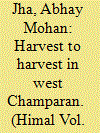

|
|
|
| 19 |
ID:
134780
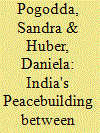

|
|
|
|
|
| Summary/Abstract |
This paper analyses India's internal peacebuilding approach in Bihar, north-east India and Jammu and Kashmir regarding its similarity with the liberal peace and its effectiveness in terms of conflict transformation. By focusing on the human rights and needs components of Indian peacebuilding, we investigate whether state interventions have managed to transform the local conflict spheres in their political, economic, societal and gender/family dimensions. Drawing on fieldwork carried out between 2011 and 2013, the paper remains sceptical about both the novelty and effectiveness of the Indian peacebuilding approach.
|
|
|
|
|
|
|
|
|
|
|
|
|
|
|
|
| 20 |
ID:
039261
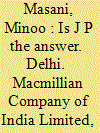

|
|
|
|
|
| Publication |
DelhI, Macmillian, 1975.
|
| Description |
133p.pbk
|
| Standard Number |
333901045
|
|
|
|
|
|
|
|
|
|
|
|
Copies: C:1/I:0,R:0,Q:0
Circulation
| Accession# | Call# | Current Location | Status | Policy | Location |
| 015561 | 954.051/MAS 015561 | Main | On Shelf | General | |
|
|
|
|
|
|
|
|
|